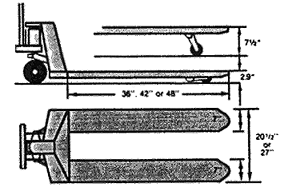What are Pallet Jacks?

Pallet jacks are truly the unsung workhorses of the warehouse. These pallet transporters get used and abused on a daily basis, but as a testament of their usefulness, dock workers and warehouse employees return to them over and over again.
Choosing a manual pallet truck is a relatively straight forwarded process that can be summed up in 3 easy steps:
Step 1: Decide on the Pallet Jack Type
Low profile manual pallet jacks have the same basic features of the standard manual pallet jacks but with a lowered fork height of 2" and a raised fork height of 5¼". Low profile models were designed for use with low clearance or disposable pallets. The load capacity of the standard units is an industry standard 5,500 lbs. while the low profile models can hold up to 4,400 lbs.

Measurements
Step 2: Determine the Width Required
Measure inside to inside of the outer pallet stringers of your pallets. Select the fork width that gives you at least 1” clearance on either side of the forks.
Step 3: Determine the Fork Length Required
If pallets are all one size, select the pallet truck fork length which matches the stringer length. If pallet sizes vary, select the longest fork length to accommodate the longest pallet.
Other special pallet truck types are also available for additional utility and functionality.
(see below)
Specialty Pallet Jacks
Several types are also available for more specialized uses. Some of these jacks and their benefits are listed below.
Lo-Profile Pallet Jacks - These jacks are specially designed so that their lowered fork height is only 2" off the ground. Although their total load capacity is less than a standard manual pallet jack, the lower fork height can be very useful for some.
Pallet Jacks for Corrosive and Sanitary Environments - Galvanized, zinc, chrome plated or stainless steel - These trucks are designed for corrosive or wet environments. Typically, they can be found in pharmaceutical, medical, food and otherwise wet settings. These types of pallet jacks will last a long time in harsh environments.
Wheel Nose/Snub Nose Pallet Jacks - This design is for positioning pallets or skids closely in a row. The fork end is set back from the front rollers allowing for one pallet pick up at a time.
Pallet Jacks with Built-in Scale - This design allows you to weigh your load on the spot. The scale is selectable in a variety of increments to adjust to the size of your load. It's digital filtering option is used to help compensate for vibration. Also available with a printer.
All Terrain Pallet Jack - This is a newcomer to the pallet jack family, but has been adopted rapidly by professionals who haul pallets over rough surfaces. Commonly, landscape companies use these to transport skids full of fill material or sod. These units are also available as motorized all terrain pallet trucks.
PowerPallet Pallet Jack & Motor Assembly - This power pallet jack makes converting a manual pallet jack to an electric pallet jack a breeze. It offers a complete drive package that can be installed onto your manual jack, converting it into a very powerful, yet ultra-compact, motorized jack.
Pallet Jack Features & Benefits
- Three position hand control for lowering, lifting and neutral positions. No foot pedal means extra safety
- Heavy duty hydraulic system - The result of years of research and development, includes a load limiter that prevents premature wear resulting from overloading
- Leak-proof pump assures maintenance-free service
- Tough nylon or polypropylene wheels and rollers
- Only 1 snap-ring and 4 pins to remove the hydraulic unit
- Hard chrome-plated ram and piston
- Sealed ball bearings at all pivot points can be lubricated easily
- Painted quality safety yellow color after anti-rust treatment
- High tensile steel frame
- Double box fork section


